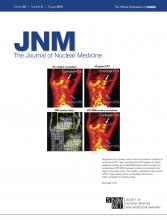About the Cover
Cover image

Respiratory and cardiac motion is the most serious limitation to whole-body PET. Here, reconstructed PET images of a freely breathing monkey show that MRI-based motion correction in simultaneous PET/MRI increases contrast and resolution but does not increase noise. This results in significant improvement in PET image quality and is a compelling rationale for further evaluation in clinical studies.
See page 1284.



